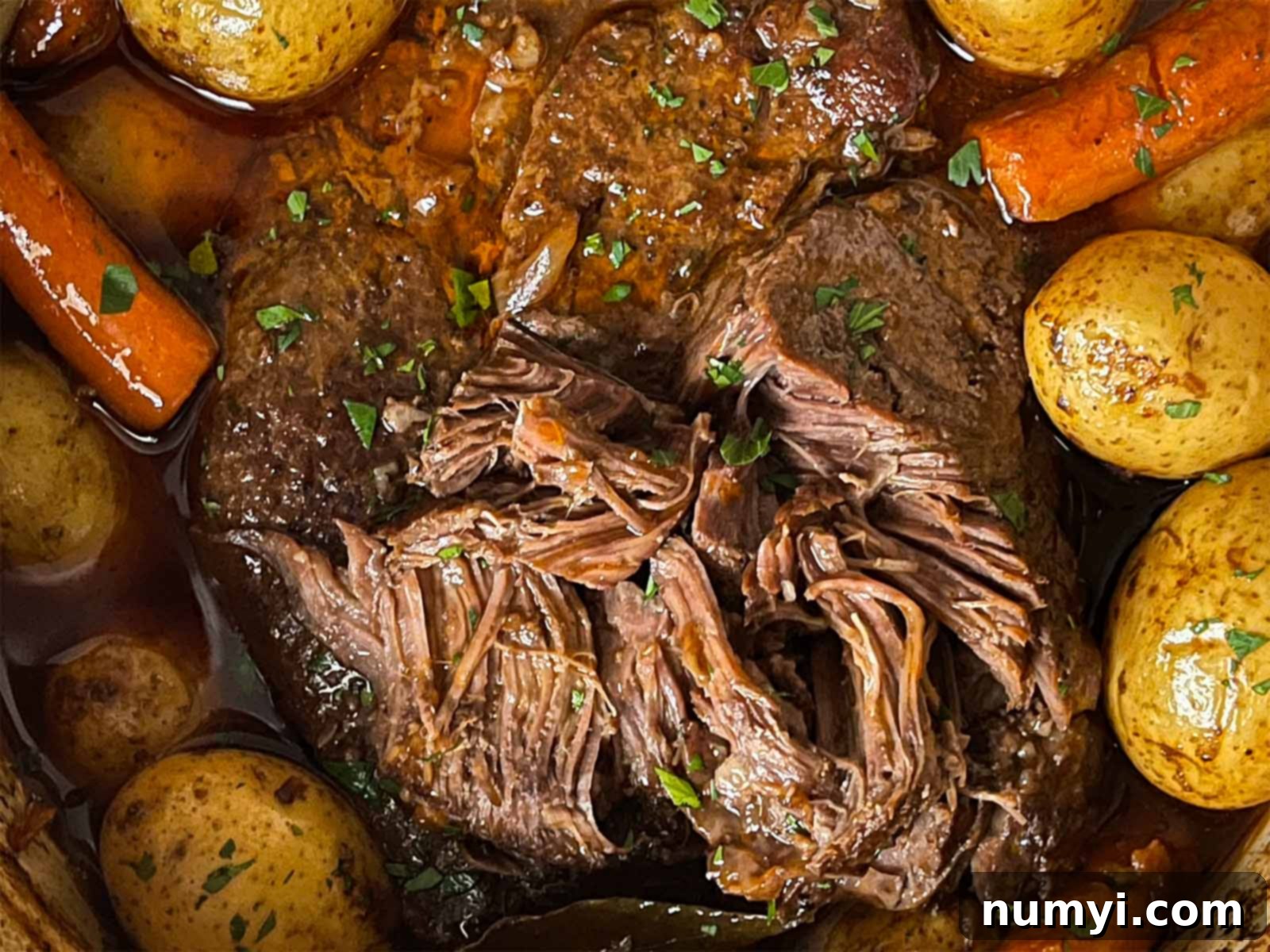Classic Pot Roast: The Ultimate Comfort Food for Tender Braised Beef, Potatoes & Carrots
There’s nothing quite like a classic pot roast to bring warmth and comfort to your home. This timeless recipe features succulent, melt-in-your-mouth tender beef, slow-braised to perfection alongside creamy potatoes and sweet carrots, all enveloped in a rich, velvety broth. It’s the quintessential comfort food, perfect for a cozy Sunday dinner or any evening when you crave a hearty, soul-satisfying meal.
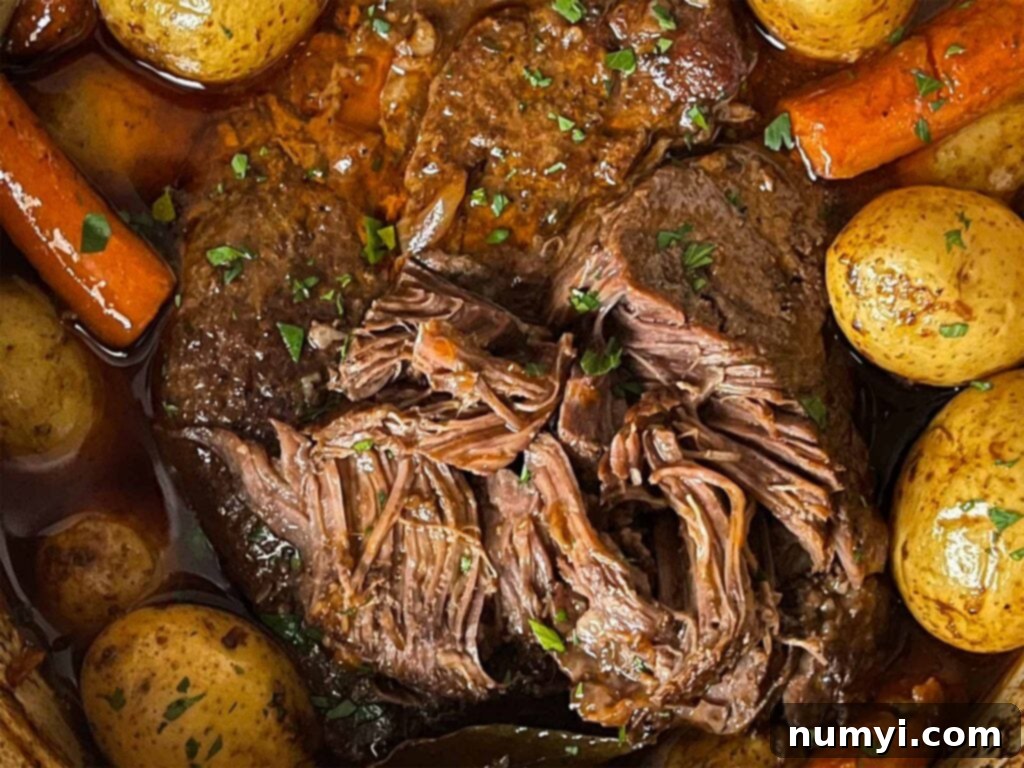
Don’t Sweat The Recipe is supported by its readers. We may earn a commission if you purchase through a link on our site. Learn more.
Why You’ll Love This Ultimate Classic Pot Roast
More than just a meal, classic pot roast is an experience. It evokes cherished memories of home, warmth, and family gatherings. Imagine a cold evening, and the aroma of slow-cooked beef and vegetables filling your kitchen – that’s the pure comfort this dish delivers. Here are a few compelling reasons why this recipe will become a favorite in your household:
- The Ultimate Comfort Food: Pot roast is the epitome of hearty, warming comfort food. Each bite brings a wave of nostalgia, making it perfect for cold nights, family dinners, or any occasion that calls for a truly satisfying meal.
- Melt-in-Your-Mouth Tender Beef: The magic of slow braising transforms an economical cut of beef into an incredibly tender, fall-apart sensation. The long, gentle cooking process breaks down tough connective tissues, infusing the meat with flavor and creating a luxuriously soft texture that genuinely melts in your mouth.
- Simple to Prepare with Minimal Hands-On Time: Despite its impressive results, this pot roast requires surprisingly little effort. Once assembled in your Dutch oven, the oven does most of the work, allowing you to focus on other tasks. Plus, cooking everything in one pot significantly simplifies cleanup, making it ideal for busy weeknights or relaxed weekends.
- Budget-Friendly & Feeds a Crowd: Pot roast is a smart and economical choice for feeding a family or hosting a dinner party without breaking the bank. It utilizes affordable cuts of beef that become extraordinary with slow cooking, stretching well to provide ample servings of deliciousness for everyone.
- Rich & Savory Flavor Profile: The harmonious combination of perfectly seared beef, aromatic vegetables like sweet onions and pungent garlic, fragrant herbs such as thyme and bay leaves, and a deep red wine and beef broth base creates an unparalleled depth of flavor. Each bite is a savory symphony, rich and deeply satisfying to the core.
If you’re looking for other comforting main dishes, some of our favorite Comfort Meal recipes include an Easy Meatloaf Recipe, One Pan Roasted Chicken and Vegetables, Creamy Potato Corn Chowder, Spicy Shrimp and Cajun Polenta, Slow Cooker Beef Tips and Gravy, and a Stuffed Bell Pepper Recipe. They all deliver that cozy, homemade feeling!
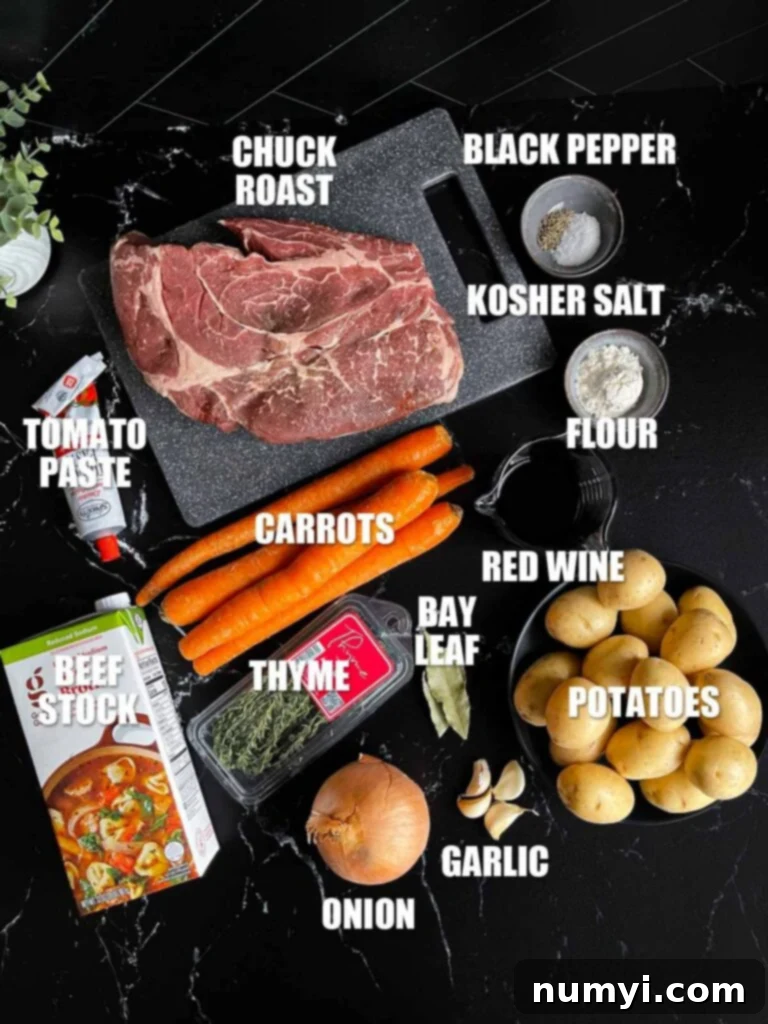
Before diving into the detailed instructions, please consult the full recipe card below for a comprehensive list of ingredients, precise measurements, and step-by-step guidance to ensure your pot roast is a resounding success.
How to Make Classic Pot Roast in the Oven
Creating this exquisite classic pot roast is a straightforward process, primarily relying on the magic of slow cooking in a Dutch oven. Here’s a detailed step-by-step guide to ensure your pot roast turns out perfectly tender and flavorful every time:
-
Preheating your oven to 325°F is the first crucial step. While the oven preheats, take your chuck roast and generously season all sides with kosher salt and freshly ground black pepper. This initial seasoning is vital for building layers of flavor right from the start.
-
In a Dutch oven or heavy pot, heat the olive oil over medium-high heat until shimmering. Carefully place the seasoned beef into the hot oil and sear it on all sides until a deep, golden-brown crust forms – typically about 4 minutes per side. This browning step, known as the Maillard reaction, is absolutely essential for developing rich, complex flavors. Once adequately seared, remove the beef to a clean platter. Next, stir in the tomato paste into the hot pan, cooking for about one minute to deepen its flavor. Then, sprinkle in the all-purpose flour and cook for another minute or two, creating a roux that will help thicken your sauce. Finally, pour in the red wine and use a wooden spoon to scrape up all those delicious browned bits from the bottom of the pan (deglazing). Allow the wine to reduce for about 1 minute, concentrating its flavors.
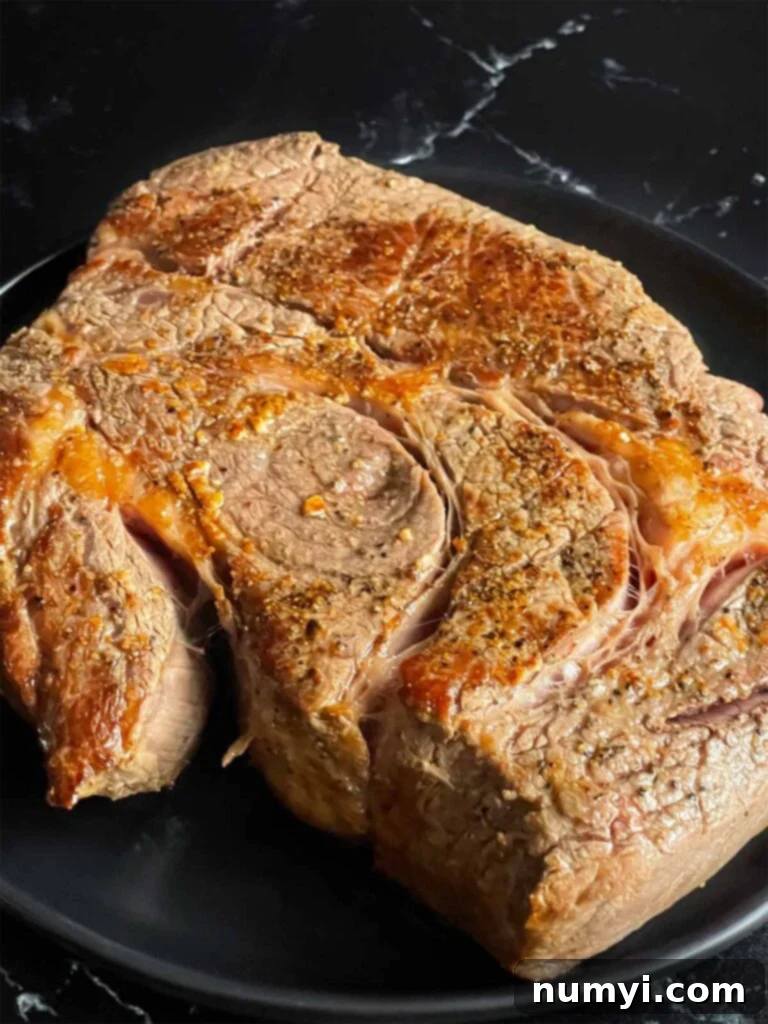
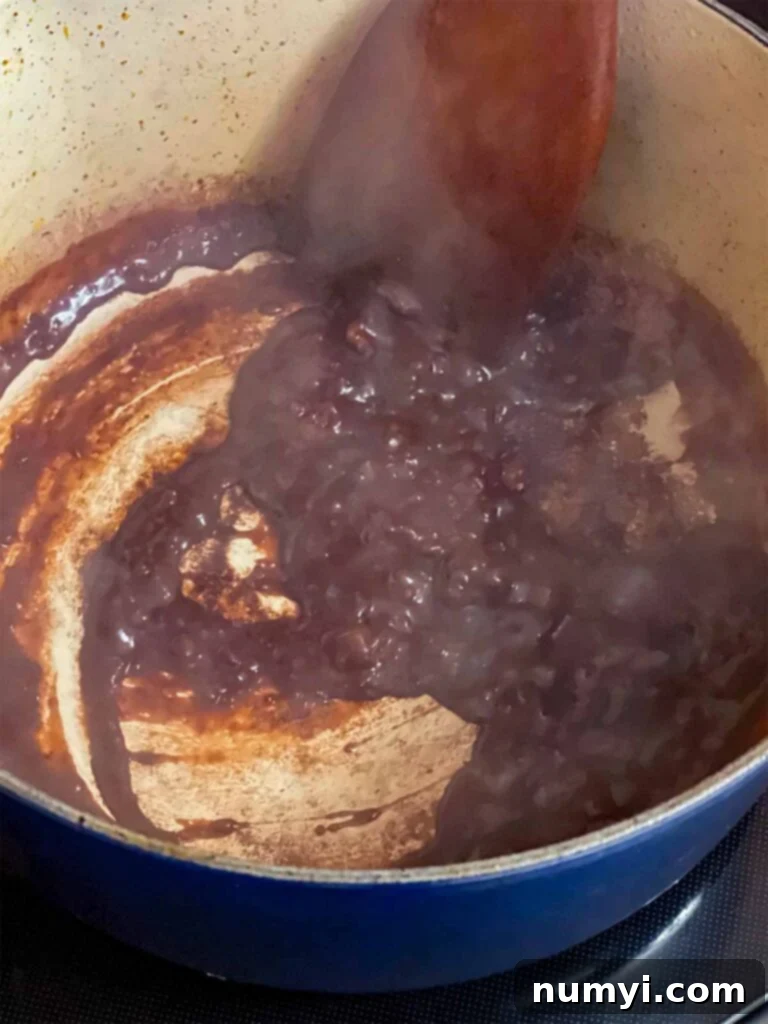
-
Return the seared beef to the Dutch oven. Add the beef broth, fresh thyme sprigs, and bay leaves around the meat. Incorporate the large pieces of yellow onion and minced garlic. Cover the pot tightly with its lid and place it in your preheated oven. Let it braise for 1 1/2 hours. This initial cooking period allows the beef to begin tenderizing and the flavors to meld beautifully.

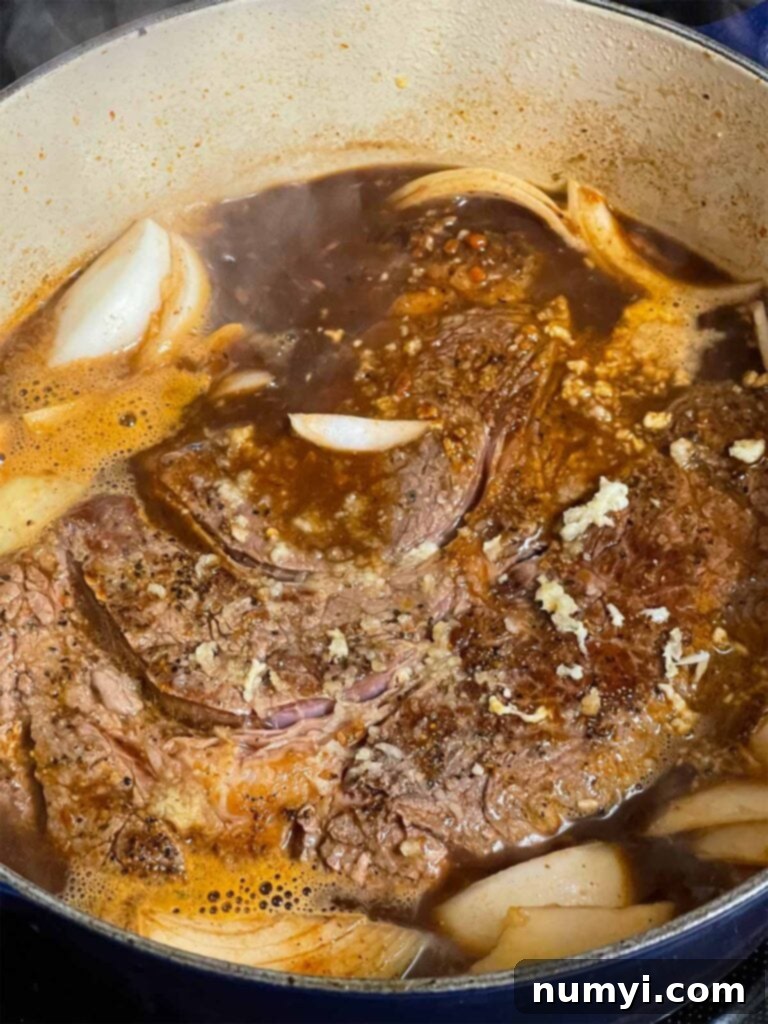
-
After the initial cooking time, carefully remove the pot from the oven. Add the small yellow potatoes and 2-inch pieces of carrots, tucking them snugly around the pot roast. Don’t worry if some vegetables aren’t fully submerged in the liquid; they will steam and cook to perfection. Return the covered pot to the oven and continue cooking for another 1 1/2 to 2 hours, or until both the roast and vegetables are incredibly fork-tender. The beef should easily shred with minimal effort.
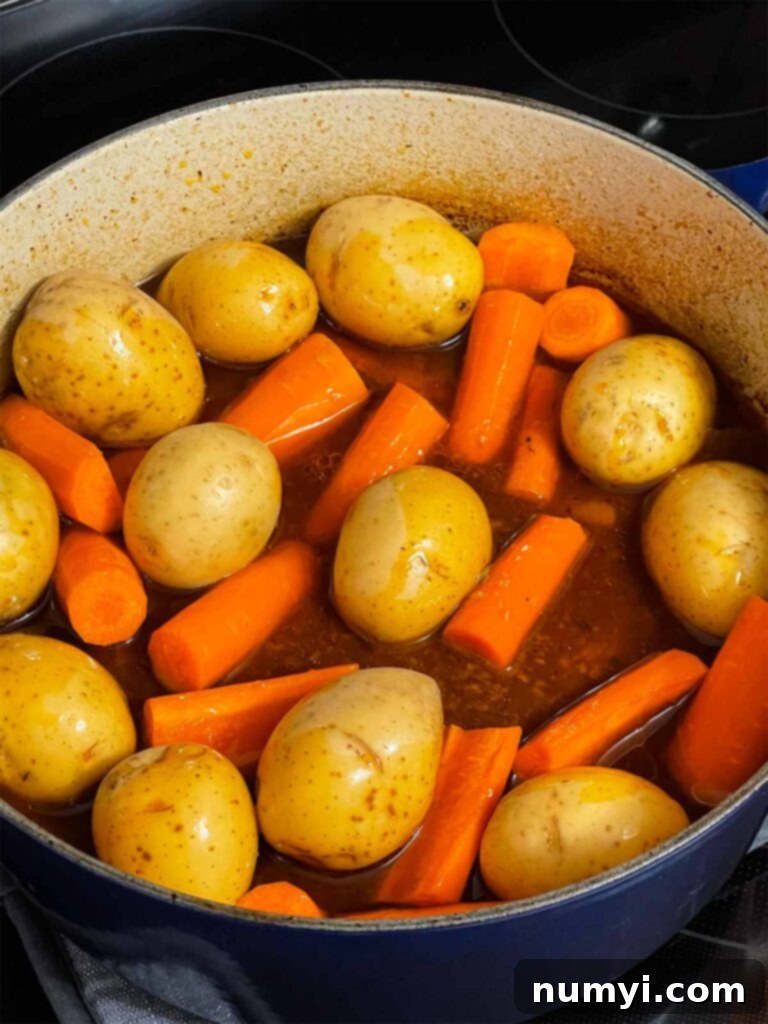

What to Serve with Pot Roast
This classic pot roast, with its tender beef, creamy Yukon Gold potatoes, and sweet carrots, truly is a complete and satisfying meal all on its own. However, if you’re looking to elevate your dinner experience or round out the meal for a larger gathering, there are several delicious accompaniments that pair wonderfully:
- Freshly Baked Breads: A basket of warm, buttery Homemade Crescent Rolls or crisp, garlicky Garlic Bread is perfect for soaking up every last drop of that rich, velvety gravy. For a touch of Southern charm, consider our Sweet Potato Biscuits.
- Light Salads: To cut through the richness of the pot roast, a vibrant side salad like our Arugula Fennel Salad offers a refreshing contrast with its peppery notes and crisp texture. Alternatively, a simple green salad with a bright vinaigrette works beautifully.
- Additional Vegetables: While the recipe includes carrots, you can never have too many vegetables. Our Slow Cooker Green Beans offer a comforting, savory addition.
- Creamy Mashed Potatoes: For the ultimate indulgence, serve this pot roast over a generous bed of fluffy, fast and delicious mashed potatoes. The extra creaminess perfectly complements the tender beef and rich gravy.
Expert Tips for the Best Pot Roast
Achieving a truly exceptional pot roast is easy with a few simple techniques. Follow these tips for a perfectly tender and flavorful dish every time:
- Potatoes and Carrots Timing: If you prefer your root vegetables to be incredibly soft and practically melt into the sauce, feel free to add them at the very beginning of the cooking process with the beef. This longer cooking time will result in an even more integrated flavor and texture.
- Choose Marbled Meat for Flavor: Selecting a chuck roast with good marbling (streaks of fat running through the meat) is key to a flavorful and juicy pot roast. The fat renders down during slow cooking, basting the meat and adding an incredible depth of flavor and moisture.
- Onion Size Matters: For this recipe, we recommend cutting the yellow onions into larger, roughly 2-inch pieces. This allows them to soften and sweeten over the long cooking time without completely disappearing into the sauce, providing a lovely textural contrast. However, if you prefer them to mostly dissolve, you can dice them smaller.
- Potato Choices: Small yellow or red baby potatoes are ideal for pot roast as they tend to hold their shape well while becoming wonderfully creamy. Russet potatoes, while still delicious, contain more starch and are more likely to break down and become very soft, almost mashed, within the pot. Both options are tasty, so choose based on your desired texture.
- Evenly Cut Carrots: To ensure your carrots cook uniformly and reach perfect tenderness without turning mushy, cut them into pieces of roughly equal size, about 2 inches long. This promotes consistent cooking.
- Fresh vs. Dried Herbs: Fresh herbs, especially fresh thyme, offer a more vibrant and aromatic flavor profile. If using dried thyme as a substitute, remember that dried herbs are more concentrated. Use approximately ½ teaspoon of dried thyme for every 3 sprigs of fresh thyme called for in the recipe.
- Control Your Salt Level: I prefer to use reduced-sodium beef broths so that I can have greater control over the final salt content of my dish. If you opt for regular beef broth, reduce the initial amount of kosher salt used to season the beef to about ½ teaspoon, and then adjust the seasoning of the sauce to taste at the end of cooking.
- Patience is Key – Don’t Rush! The most critical tip for a truly fall-apart tender pot roast is not to rush the cooking time. If after the recommended 3 hours the meat isn’t effortlessly shreddable with a fork, continue cooking it, checking every 30 minutes, until it reaches that desired tenderness. Low and slow is the mantra for perfect pot roast.
Delicious Variations for Your Pot Roast
While we believe this is the best classic pot roast recipe with potatoes and carrots, there’s always room for creative adjustments to suit your taste or what you have on hand. Here are some delicious variations to consider:
- Root Vegetable Alternatives: Beyond classic potatoes and carrots, experiment with other hearty root vegetables. Parsnips add a slightly sweet, earthy flavor, turnips contribute a subtle peppery note, and rutabagas offer a unique, savory sweetness. Sweet potatoes can also be a wonderful addition for a different flavor profile.
- Herb Swaps: Not a fan of thyme? Fresh rosemary is an excellent substitute, offering a more robust, piney aroma that complements beef beautifully. For a milder, earthy touch, a sprig or two of fresh oregano can also be used.
- Flavor Boosters: Consider adding a splash of Worcestershire sauce or a teaspoon of Dijon mustard to the broth for an extra layer of umami and tang. A couple of anchovy fillets (they’ll dissolve completely) can also deepen the savory notes without tasting fishy.
- Spice It Up: For a subtle kick, a pinch of red pepper flakes or a dash of smoked paprika can add warmth and complexity to the dish.
- Different Liquids: While red wine is classic, you can substitute it with dark beer (like stout or porter) for a malty depth, or simply use extra beef broth for an alcohol-free version. A splash of balsamic vinegar can also add a nice acidity and richness.
Frequently Asked Questions About Classic Pot Roast
Choosing the right cut of beef is fundamental to achieving a tender and flavorful pot roast. The best cuts are those with a good amount of connective tissue and marbling, which break down during long, slow cooking, resulting in succulent meat.
Beef Chuck (Our Favorite!): Sourced from the shoulder, chuck roast boasts excellent marbling and a good amount of connective tissue. This makes it ideal for slow braising, as the collagen melts into gelatin, creating incredibly tender, juicy, and flavorful results that effortlessly fall apart.
Bottom Round, Shoulder Roast, Rump Roast: These cuts also have good marbling and will yield a delicious, juicy, and tender roast when cooked slowly. They are excellent alternatives to chuck roast.
Round Roast: Generally leaner than other options, round roast can be used but requires more careful monitoring to prevent it from drying out. It’s not our top recommendation for the best pot roast experience.
Brisket: A notoriously tough cut, brisket shines in slow-cooking applications. The long braising process breaks down its fibers, releasing rich natural flavors and transforming it into fall-apart tender perfection.
Absolutely! Pot roast is a quintessential slow cooker dish. First, brown the chuck roast thoroughly in a skillet on all sides, then transfer it to your slow cooker crock. Follow the instructions for preparing the sauce in the same skillet (tomato paste, flour, red wine), then pour it over the beef in the slow cooker. Add the beef broth, herbs, onions, and garlic. Cook on the LOW setting for 8-10 hours, or on HIGH for 5-6 hours, until the meat is undeniably pull-apart tender. The low setting is generally preferred for the most consistently tender results.
A pot roast is perfectly done when it reaches an internal temperature of 190-200°F (88-93°C) and, most importantly, when it breaks apart easily with just a fork. The meat should be shreddable, not firm or chewy.
If you desire a thicker, richer gravy to accompany your pot roast, here’s how to achieve it: Once the roast and vegetables are fork-tender, carefully remove them from the pot and transfer them to a platter. Loosely tent them with aluminum foil to keep warm. In a small bowl, whisk together 2 tablespoons of cornstarch (or all-purpose flour) with 2 tablespoons of cold water to create a smooth slurry. Place the Dutch oven with the remaining liquid on the stovetop over medium heat. Gradually whisk in the cornstarch slurry. Bring the mixture to a boil, stirring constantly, and allow it to simmer for 1-2 minutes until it thickens to your desired consistency. Taste and adjust seasonings.
To store leftover pot roast, allow it to cool completely to room temperature. Transfer the beef, vegetables, and any remaining gravy into an airtight container. Refrigerate for up to 4 days.
Yes, pot roast freezes beautifully! Ensure the pot roast is entirely cooled. Place it in a freezer-safe, airtight container or heavy-duty freezer bags. You can freeze it whole, in chunks, or shredded with the gravy and vegetables. It will keep well in the freezer for up to 3 months. Thaw frozen pot roast overnight in the refrigerator before reheating.
Reheating pot roast requires a gentle approach to prevent it from drying out. The oven can sometimes be too harsh for reheating.
You can reheat it on the stovetop: Place the leftover pot roast in a pot with a splash of beef broth. Heat over low to medium heat, covered, for 10-15 minutes, or until the beef has absorbed most of the broth and is warmed through. If you have vegetables, add them for the last 5-10 minutes. This method helps keep the meat moist.
You can reheat it in a slow cooker: For larger quantities, or if the meat is already shredded or in smaller chunks, transfer the leftovers to a slow cooker. Add the cooking liquids from the original meal, along with a little extra beef broth if needed to ensure everything is covered. Cook on LOW for 3-4 hours (for larger pieces) or 1-2 hours (for shredded/smaller chunks) until thoroughly warmed.
More Hearty Beef Recipes to Enjoy
If you loved this Classic Pot Roast, you’ll be thrilled to explore more of our delicious beef recipes that promise flavor and satisfaction:
Braised Beef Cheeks
Garlic Herb Beef Top Round Roast
Crock Pot Mississippi Pot Roast
Are you on Pinterest? Click the button below to add this recipe to one of your boards!
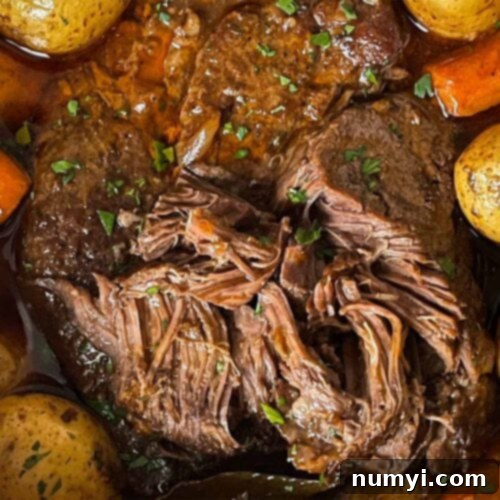
Classic Pot Roast
Print
Pin
Rate
Dinner, Main Course
American
15 minutes
3 hours
8
481
kcal
Leigh Harris
Ingredients
- 3-4 lb Chuck roast
- 1 tsp Kosher salt
- 1/2 tsp Black pepper
- 2-4 tbsp Olive oil
- 1 tbsp Tomato paste
- 2 tbsp All-purpose flour
- 1/2 cup Red wine
- 2 cups Reduced-sodium beef broth
- 3 sprigs Fresh thyme or 1/2 teaspoon dried thyme
- 2 Bay leaves
- 1 medium Yellow onion cut into large 2″ pieces
- 4 cloves Garlic minced
- 2 lbs Small yellow potatoes
- 1 lb Carrots cut into 2″ pieces
Instructions
-
Preheat oven to 325 degrees F. Season the beef well on all sides with kosher salt and black pepper.3-4 lb Chuck roast, 1 tsp Kosher salt, 1/2 tsp Black pepper
-
In a dutch oven or heavy pot with a lid over medium-high heat, heat the olive oil. Brown the meat on both sides, about 4 minutes per side. Remove the meat to a platter. Stir in the tomato paste, and cook for about one minute. Add the flour and cook another minute or two. Add the red wine and deglaze the pan, reduce the wine for about 1 minute.2-4 tbsp Olive oil, 1 tbsp Tomato paste, 2 tbsp All-purpose flour, 1/2 cup Red wine
-
Add the beef broth, thyme, and bay leaves. Add the seared beef, onions, and garlic. Cover the pot and cook in the preheated oven for 1 1/2 hours.2 cups Reduced-sodium beef broth, 3 sprigs Fresh thyme, 2 Bay leaves, 1 medium Yellow onion, 4 cloves Garlic
-
Add the potatoes and carrots tucking them around the roast (it’s ok if they all don’t fit under the sauce in the pan they will still cook) and cook for another 1 1/2 hours to 2 hours until roast and vegetables are fork tender.2 lbs Small yellow potatoes, 1 lb Carrots
-
Season to taste with additional salt and pepper if needed. Remove the bay leaves and thyme stems and serve the beef shredded or in chunks.
Notes
See FAQ section of the post for storing, freezing, and reheating.
Nutrition
Carbohydrates: 29g |
Protein: 37g |
Fat: 23g |
Saturated Fat: 9g |
Polyunsaturated Fat: 2g |
Monounsaturated Fat: 12g |
Trans Fat: 1g |
Cholesterol: 117mg |
Sodium: 602mg |
Potassium: 1415mg |
Fiber: 5g |
Sugar: 5g |
Vitamin A: 9548IU |
Vitamin C: 28mg |
Calcium: 72mg |
Iron: 5mg
